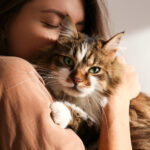Cats are renowned for their love of sleep, often dozing for up to 16 hours a day, and sometimes even more as they get older. As a cat owner, you’ve likely witnessed your feline companion in a variety of sleeping poses, some of which might seem quite peculiar. Have you ever wondered what it means when your cat sleeps all curled up or sprawled out in a full stretch? Understanding these positions can offer a fascinating glimpse into your cat’s comfort, security, and even their wild instincts. Let’s delve into the world of feline sleep postures and uncover what they reveal about your beloved pet, with a special focus on those moments when your Cat Stretched out and relaxed.
1. Curled Into a Ball
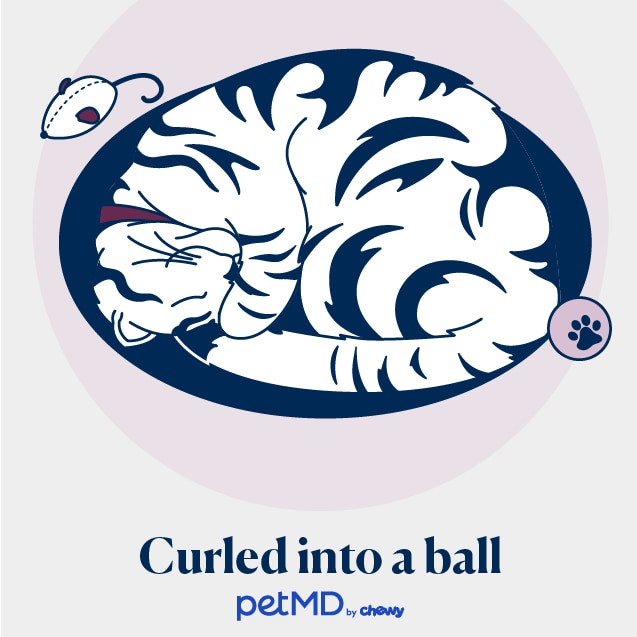 cat sleeping curled-up into a ball
cat sleeping curled-up into a ball
One of the most common sleeping positions is when a cat curls into a tight ball, often tucking their nose close to their tail. This classic pose is all about warmth and protection. By curling up, cats conserve body heat, a crucial factor, especially in cooler environments. Furthermore, this position instinctively shields their vulnerable abdominal organs, safeguarding them with layers of muscle and bone. When you see your cat in this position, it’s likely they are prioritizing warmth and security.
2. On Their Back
 cat sleeping on their back
cat sleeping on their back
Witnessing your cat sleeping on their back, with their belly fully exposed and legs relaxed or outstretched, is a sign of ultimate trust and confidence. Cats are naturally protective of their vital organs, so this vulnerable posture indicates they feel completely safe and secure in their environment. While it might be tempting to give that exposed belly a rub, proceed with caution! Even in this relaxed state, many cats retain their instinct to defend themselves if their belly is touched, and you might be met with a swat or a nip.
3. Side Sleeping
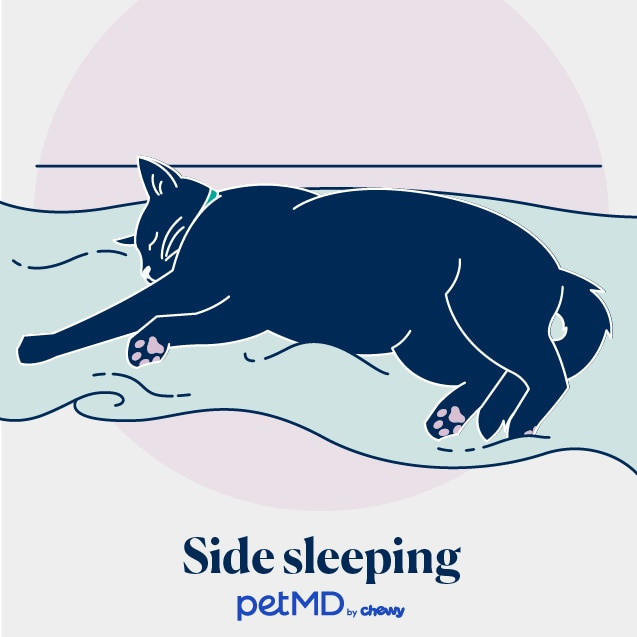 cat sleeping on their side
cat sleeping on their side
Similar to back sleeping, a cat sleeping on their side with legs extended also signifies comfort and relaxation. With their vital organs somewhat exposed, this position demonstrates a level of trust in their surroundings and their safety. However, unlike back sleeping, side sleeping offers a quicker escape route. As both predators and prey, cats retain a primal awareness, and this posture allows them to spring up and react swiftly if needed, providing a sense of security even in rest.
4. In a Loaf Shape
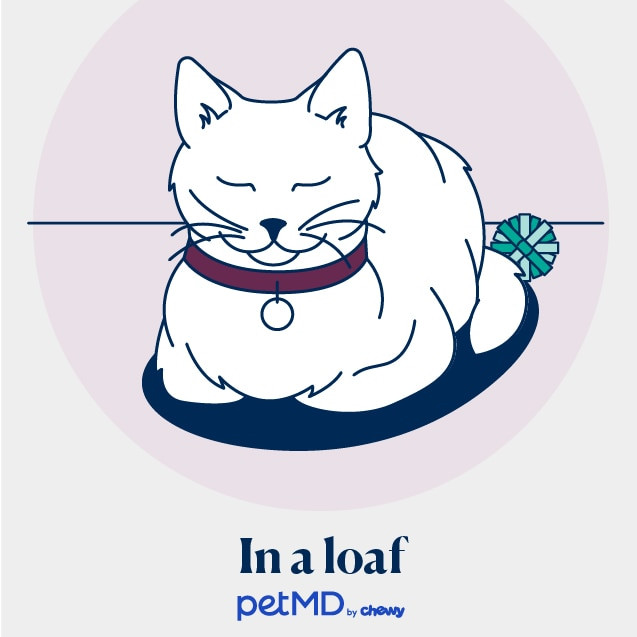 cat sleeping in a loaf
cat sleeping in a loaf
The “loaf” position, where a cat tucks their front paws under their body while keeping their head upright, resembles a loaf of bread. This posture is a blend of relaxation and alertness. While seemingly comfortable, it’s a semi-alert state. The tucked paws help conserve warmth and protect vital organs, but the cat is still poised to react quickly if necessary. Cats in a loaf position are often just resting, ready to spring into action if something catches their attention.
5. The Superman Pose
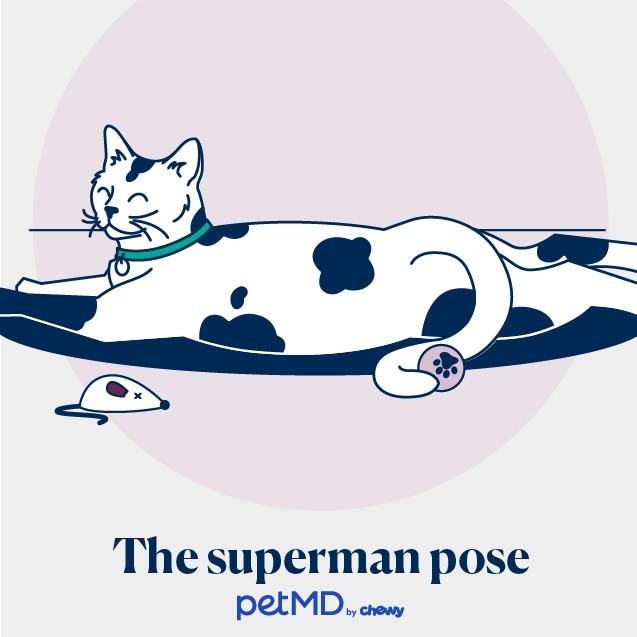 cat sleeping in a superman pose
cat sleeping in a superman pose
When a cat stretches out fully on their belly, with front legs extended forward and back legs stretched behind, it’s often referred to as the “Superman” pose. This position can indicate deep relaxation, but it also leaves them ready for action. All four paws are extended, prepared for a quick getaway if needed, while still offering protection to their belly. Cats might choose this pose when resting on a warm surface like a blanket to conserve heat, or on a cool surface like tile to cool down on a warmer day.
6. Perched on Furniture or Appliances
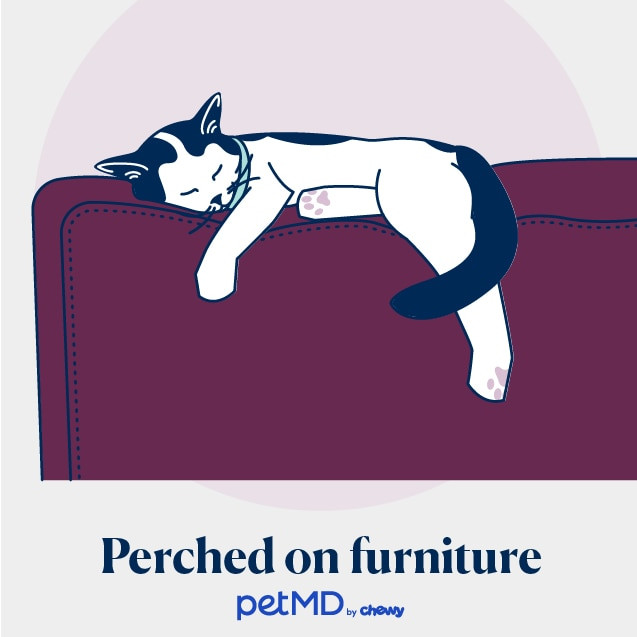 cat sleeping on the back of a couch
cat sleeping on the back of a couch
Finding your cat asleep perched precariously on the back of the couch, a chair armrest, or even the refrigerator might seem odd, but it serves several purposes. A high vantage point offers a sense of security, away from potential “predators” in the household, be it other pets, children, or unfamiliar guests. Furthermore, this elevated position provides a panoramic view, allowing your cat to keep an eye on their territory and any potential “prey”—which in a domestic setting, is more likely to be a toy than a mouse, but the instinct remains.
7. In Strange Positions
 cat sleeping in a strange position
cat sleeping in a strange position
Cats are renowned for their flexibility, and sometimes their sleeping positions reflect this in seemingly contorted and uncomfortable ways. However, what looks awkward to us is likely perfectly comfortable for them. Their highly elastic spinal discs and loosely attached shoulder blades grant them an exceptional range of motion, allowing them to twist and bend into positions we can only marvel at. These strange positions are simply a testament to their incredible agility and flexibility.
8. Sitting Upright
 cat sleeping while sitting up
cat sleeping while sitting up
A cat dozing in a sitting position, resembling a human posture, is often a sign of confidence and security in their environment. By sitting upright, they expose their belly, indicating they feel safe and unthreatened. This position also offers practical benefits, making it easier for them to groom their belly with minimal effort between naps. Additionally, sitting upright might provide support for their back muscles, offering a comfortable resting posture.
9. On Your Chest
 cat sleeping on a human
cat sleeping on a human
If your cat chooses to sleep on your chest, it’s often a clear sign of bonding and affection. They seek closeness and comfort with their favorite human. Sleeping near your chest allows them to be close to your face, potentially finding comfort in your voice and breath. Furthermore, the rhythmic sound of your heartbeat and breathing can be soothing, much like it is for infants. And of course, your chest provides a wonderful source of warmth.
10. Next to You
 cat sleeping next to a human
cat sleeping next to a human
Sleeping next to you, but not directly on you, doesn’t indicate a lack of affection. It simply suggests a cat who is bonded to you but prefers a slight buffer zone, at least while sleeping. This position still conveys trust and comfort in your presence, acknowledging your bond while maintaining a sense of personal space. It’s their way of saying “I love you, but I also need a little room.”
11. On Your Head
 cat sleeping on a person
cat sleeping on a person
When cats sleep near or on your head, practical reasons are often at play. Your head, resting on a soft pillow, provides a comfortable and soft sleeping surface. Additionally, your head tends to move less during sleep compared to the rest of your body, offering a less disruptive resting place. Beyond comfort, cats are creatures of habit and often adapt to their owner’s sleep schedule. Sleeping by your head is a way to stay close to you throughout the night and have easy access to wake you up for food or attention when they deem it necessary.
12. On Your Feet
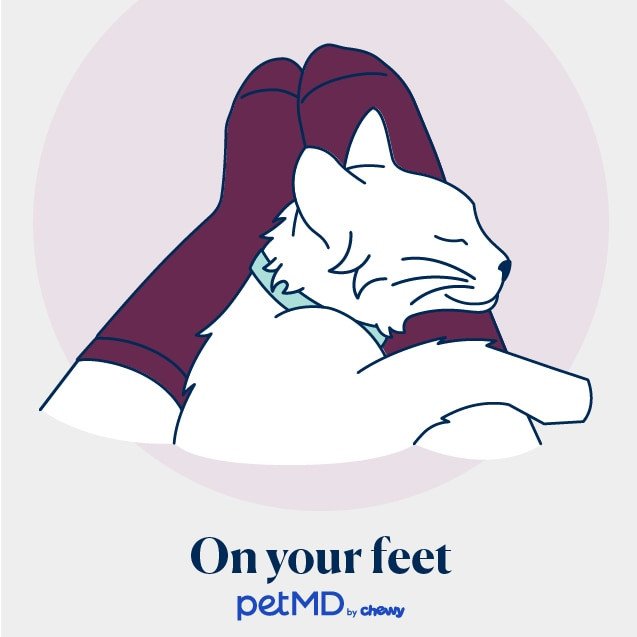 cat sleeping on a person
cat sleeping on a person
A cat sleeping at your feet might be keeping your toes warm, but they are also likely seeking warmth from you. This position allows them to be near you while also maintaining a sense of security and easy escape, being positioned near the edge of the bed, couch, or chair. It’s a balance of proximity and independence.
13. Between Your Legs
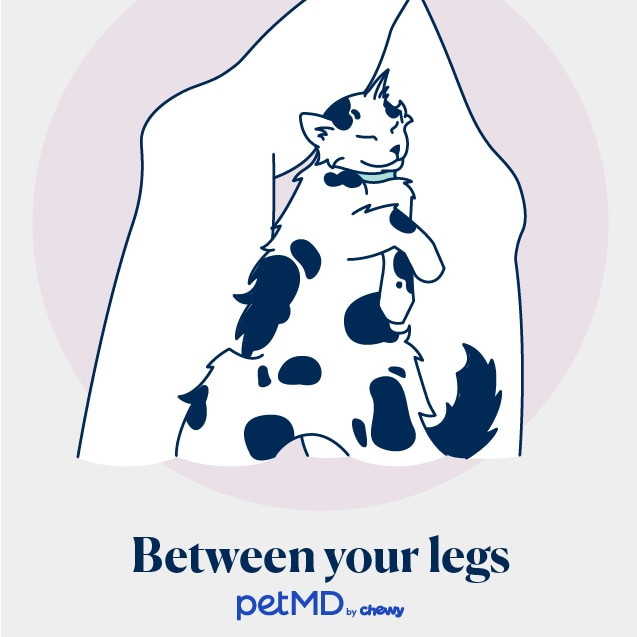 cat sleeping between a person
cat sleeping between a person
While it might be slightly less comfortable for you, a cat sleeping nestled between your legs offers numerous benefits for them. It provides close contact with you, and your legs create a warm, secure, and nest-like haven for them to curl up in. Despite the snuggle, they still maintain an easy escape route if needed, blending comfort and security.
14. In a Box
 cat sleeping in a box
cat sleeping in a box
The feline fascination with boxes stems from their instinctual need for security as prey animals. Boxes provide a sense of enclosure, a safe haven to retreat to. They offer security, warmth, and a feeling of being protected, similar to how a tent shelters humans. Even when a box seems too small, cats will often try to squeeze in, seeking that feeling of security, much like a swaddled infant.
15. In the Litter Box
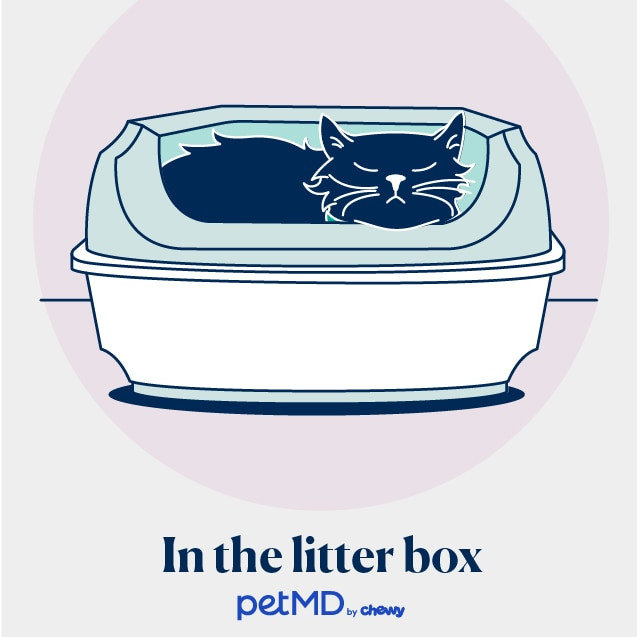 cat sleeping in a litter box
cat sleeping in a litter box
Finding your cat sleeping in their litter box is usually a cause for concern and warrants immediate veterinary attention. This behavior often indicates an underlying medical issue, such as urinary or digestive problems. While in rare cases, it might be a behavioral quirk or a response to limited safe spaces, especially in stressful environments like shelters, it’s crucial to rule out any health issues first. Contact your veterinarian immediately if your cat starts sleeping in their litter box.
16. Eyes Open or Half Open
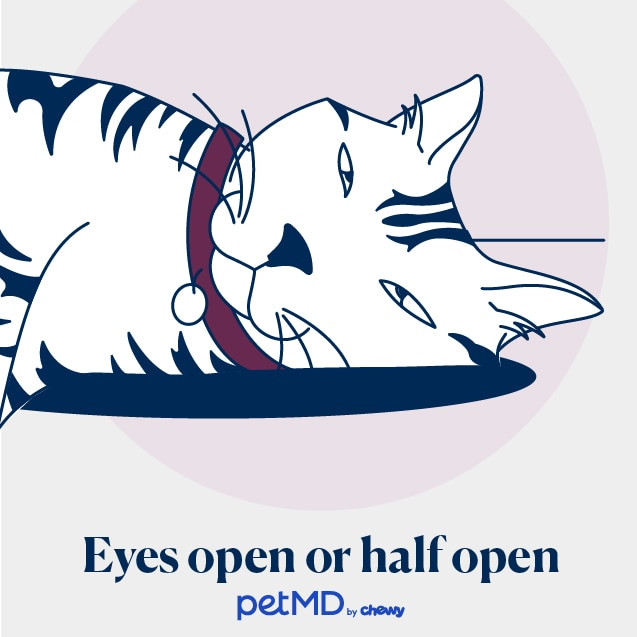 cat sleeping with their eyes open
cat sleeping with their eyes open
Cats can sleep with their eyes fully or partially open, which can be surprising to see. Sometimes, you might even observe rapid eye movement (REM) beneath their eyelids, indicating they are in the dreaming stage of sleep. Cats possess a third eyelid, a translucent membrane that can be visible even when their eyes are partially open. This eyelid provides protection and keeps the eye moist during sleep. While sleeping with eyes open can be normal, it’s important to rule out any medical reasons, especially if you notice other eye-related symptoms like swelling, discharge, squinting, or pawing at the eye.
17. Paws Over Eyes
 cat sleeping with a paw over their eyes
cat sleeping with a paw over their eyes
The adorable sight of a cat sleeping with their paws covering their eyes is not just cute; it’s functional. Paws over the face provide insulation and warmth for both paws and face. They also act like natural eye masks, blocking out bright light or even potential irritants like dust or pollen, creating a darker and more comfortable sleep environment.
18. With Other Cats
 two cats sleeping together in a cat bed
two cats sleeping together in a cat bed
While some cats in multi-cat households might simply tolerate each other, many develop strong bonds and enjoy sleeping together. This might involve sharing a comfy bed or cuddling up for warmth and companionship. Sleeping in a group provides shared body heat and can be soothing, with the gentle purring of one cat potentially calming others.
19. With a Dog
 cat sleeping next to a dog
cat sleeping next to a dog
Despite the stereotypical cat-dog dynamic, cats and dogs can form strong bonds, just like cats and humans. While introductions should always be careful and supervised, cats and dogs that get along well may sleep together for companionship, warmth, and mutual comfort. This interspecies snuggling highlights the adaptable social nature of cats.
20. Tucked In
 cat sleeping tucked under a blanket
cat sleeping tucked under a blanket
If your cat loves to burrow under blankets or covers, they are likely relishing the warmth and the comforting familiarity of your scent embedded in the fabric. Blankets also offer a refuge from noise, creating a quieter and more secure sleep environment for noise-sensitive cats. The feeling of being wrapped or swaddled can also provide a sense of security. While generally safe, always be mindful of your cat’s location under blankets to avoid accidentally disturbing or injuring them, and ensure the material is breathable.
Understanding your cat’s sleeping positions offers a fascinating window into their behavior and well-being. From the security of a curled ball to the confident cat stretched out on their back, each pose tells a story about their comfort level, instincts, and relationship with their environment and you. So next time you observe your cat in one of these positions, you’ll have a deeper appreciation for what their body language is telling you.


